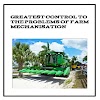Breeds of Cattle
1. Asawal
2. Sokoto Gudali
3. Kuri
4. Jerseys
5. Holstein
6. Keteku (Borgu)
7. Red Bororo
8. White Fulani
9. Wadara (Shuwa)
10. Brown Swiss.
Breeds of Cattle Classification
The breeds of cattle can be categorised into three groups.These groups are:
1. Beef Cattle : Beef cattle are the ones that has the ability to produce meat.Examples are N'dama, Kuri, Red Bororo, Rahji, Keteku, Sokoto Gudali, Red Bororo etc
2. Dairy Cattles : Dairy Cattles are the Cattles which are reared mainly for the production of milk. Examples includes; White Fulani, Dexter, Kerry, Guernsey,Red Poll, Friesian,Ayshere etc.
3. Dual Purpose Cattle: These are cattle that are capable of producing milk and meat.Examples are azawal, muturu , wadara, biu etc.
Terminologies Used in Cattle
Bull - This is an adult male cattle
Cow - This is an adult female cattle
Calf - This is a young or baby cattle
Heifer - This is a growing female cattle that is up to first calving.
Bull Calf - This is a young male cattle.
Heifer Calf - This is a young female cattle.
Ox - This is a adult castrated male cattle
Steer - This is castrated male cattle
Beef - A beef is a meat from cattle
Calving - Act of giving birth in cattle.
Serving - This is act of mating in cattle.
Herd - A group of Cattle
Polled - This is a cattle without horns
Horned - This is a cattle with horn
Humped -- Cattle with hump
Humpless - cattle without hump.
Diary cattle - These are cattle kept for milk production.
Beef cattle - These are cattle kept for meat production.
Characteristics of Cattle
1. Cattle are hardy
2. They can tolerate to heat and humidity.
3. They have late maturity like it take a very long time to mature.
4. Cattle can withstand stress and can travel long distance without water.
5. Cattle can tolerate diseases like trypanosomiasis and others.
6. Most cattle are for dual purpose ( produce milk and meat).
7. In general, cattle have long legs
8. Some cattle are humped.
9. Cattle are very powerful to be used for farm works.
Economic Importance of Cattle
1. Cattle provide meat and milk for man.
2. They provide hide and skin.
3. Fertilisers can be obtained from blood ,bone and offals of cattle.
4. Some cattle help to plough as work or draught animals.
5. Cattle dung is a very good source of manure.
6. Cattle serves as a source of revenue because they can be exported.
7. The blood and bone of cattle can be used for done meal to feed poultry.
8. Cattle serves as source of employment and income to people.
Systems of Rearing Cattle
There are three systems of rearing cattle. These are extensive, semi-intensive, and intensive System.
1. Extensive System: Extensive system of rearin cattle is the process of leaving to fed for themselves without any supervision of the owner. They are allowed to move freely. In most cases the Cattles are not provided medication. This system is the cheapest .This system requires small money to start up.Animal are been exposed to weather hazards such as excessive heat, heavy rainfall which may leads to the death of animals. Cattles can destroys people crops and thereby causing community dispute.The animal can be stolen or killed by wild animals.
2. Semi intensive System: In this system, housing and little medication is provided as the cattle are allowed to move out and graze on pastures. The animals spend more time outside than inside as they come to their pen(home) in the night. The grasses and pastures must be managed properly to provide the necessary food for the cattle. This system needs less capital investment but requires large labour as the owner. The diseases and parasite attack is grossly low.
3. Intensive System: Under this system, the cattle are confined within a building and them having limited access to grazing. Grasses,water and medication are provided to cattle under this system daily.
This system saves labour but requires large amount of money to start up. There is protection from weather adverse like rain,sun, heat etc , predators and thieves.
Housing for Cattle
1. Cattle has no formal erected house This animals are kept in krall at night to prevent wandering about.
2. In modern animals husbandry, houses are built with suitable material for the circulation of sufficient air.
3. The roof should be construed with galvanized roofing sheet for durability.
4. The floor should be made of concrete for easy cleaning because of their dung.
5. The house should be walled with sufficient windows.
Feeding of Cattle
1. The feed of cattle is must be balaced diet i.e must contain all the nutrients to enhance growth and production.
2. Cattle being ruminants , feed mainly on roughages (grass and legumes) based on the stomach they have and must be made available.
3. Cattle can feed of Common grasses like carpet grass, guinea grass and elephant grass etc and also leguminous plants like centrosema spp, calopogonium spp etc.
4. Dairy Cattle should be given more concentrate that beef because of the production of milk.
5. Preserved foods like hay, straw, silage etc.., can be fed on by cattle especially when there is no rain , where the green plants are unavailable.
Health Care and Sanitation of Cattle
1. Good feeding and housing for Cattles tends to reduce the rate of diseases attack on cattle.
2. The houses should be cleaned regularly because of diseases.
3. Sick cattle should be isolated from others and be treated.
4. Cattle should be dewormed regularly and get rid of Endoparasites like tapeworms, roundworms and liver flukes, etc.
5. Cleaning of the pens, watering and feeding equipment should be done daily.
6. Rotational grazing should be practised to avoid the building up of parasite.
Common disease of cattle
The common disease of cattle includes: foot and mouth diseases, rinderpest diseases, anthrax, tuberculosis, trypanosomiasis etc. These diseases should be prevented and good veterinary doctor should be employed.







0 Comments